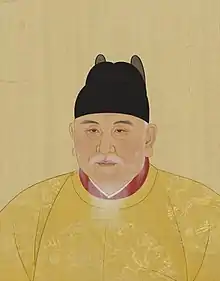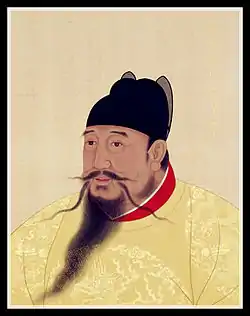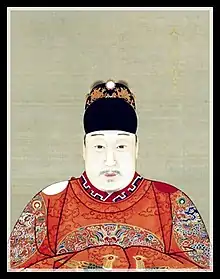| House of Zhu | |
|---|---|
 | |
| Country | |
| Founded | 23 January 1368, 655 years ago |
| Founder | Hongwu Emperor |
| Final ruler |
|
| Titles |
|
| Deposition |
|
The House of Zhu was the imperial ruling house of the Ming dynasty (1368–1644) and Southern Ming dynasty (1644–1662) of China.
Its founder was Zhu Yuanzhang, the leader of a major rebellion against the Yuan dynasty. He and his descendants lifted China to long-term economic prosperity and political stability. Over time, thanks to the polygamy common among the upper classes of Chinese society, the number of male members of the house increased to one hundred thousand. However, except for the emperors and heirs to the throne, they were excluded from politics for the sake of government stability.
From the late 16th century onwards, economic difficulties and the resulting peasant uprisings brought about a weakening of Ming power, which was used by the Qing dynasty in 1644 to seize power in the Central Plains.
Family history
Founder

The founder of the Ming dynasty was the Hongwu Emperor (21 October 1328 – 24 June 1398), who is also known variably by his personal name "Zhu Yuanzhang" and his temple name "Taizu of Ming" (literally "Great Ancestor of Ming"). He was the first emperor of the Ming dynasty. His regnal name, Hongwu, means "vastly martial". He founded the imperial family of Zhu.
In the middle of the 14th century, with famine, plagues and peasant revolts sweeping across China, Zhu Yuanzhang became a leader of an army that conquered China, ending the government of the Mongol-led Yuan dynasty, and forcing the Mongols to retreat to present-day Mongolia. With his seizure of the Yuan capital Khanbaliq (present-day Beijing), he claimed the Mandate of Heaven and established the Ming dynasty in 1368. The Ming's mission was to drive away the Mongols and restore Han Chinese rule in China.
Under the Hongwu Emperor's rule, the Mongol bureaucrats who dominated the government in the Yuan dynasty were replaced by Han Chinese officials. The Hongwu Emperor revamped the traditional Confucian examination system. Mongol-related things, including garments and names, were discontinued from use and boycotted. There were also attacks on palaces and administrative buildings previously used by the Mongol rulers.[1]
Rise of the Ming dynasty

The Hongwu Emperor's grandson, Zhu Yunwen, assumed the throne as the Jianwen Emperor (r. 1398–1402) after the Hongwu Emperor's death in 1398. In a prelude to a three-year-long civil war beginning in 1399,[2] the Jianwen Emperor became engaged in a political showdown with his uncle Zhu Di, the Prince of Yan. The Jianwen Emperor was aware of the ambitions of his prince uncles, establishing measures to limit their authority. The militant Zhu Di, given charge over the area encompassing Beijing to watch the Mongols on the frontier, was the most feared of these princes. After the Jianwen Emperor arrested many of Zhu Di's associates, Zhu Di plotted a rebellion. Under the guise of rescuing the young Jianwen Emperor from corrupt officials, Zhu Di personally led forces in the revolt; the imperial palace in Nanjing was burned to the ground. The Jianwen Emperor, his wife, mother, and courtiers were supposedly killed. Having overthrown his nephew, Zhu Di seized the throne and became known as the Yongle Emperor (r. 1402–1424); his reign is universally viewed by scholars as a "second founding" of the Ming dynasty since he reversed many of his father's policies.[3]
After his coronation, the Yongle Emperor decided to move China's capital from Nanjing (lit. "Southern Capital") to Beijing (lit. "Northern Capital"). According to a popular legend, the capital was moved when the emperor's advisers brought the emperor to the hills surrounding Nanjing and pointed out the emperor's palace showing the vulnerability of the palace to artillery attack.
The Yongle Emperor ordered construction of a massive network of structures in Beijing in which government offices, officials, and the imperial family itself resided. After a painfully long construction time, the Forbidden City was finally completed and became the political capital of China for the next 500 years.


Decline
There were many problems—fiscal or other—facing Ming China that culminated in the decline of the dynasty, starting with the reign of the Wanli Emperor (r. 1572–1620). In the beginning of his reign, the Wanli Emperor surrounded himself with able advisors and made a conscientious effort to handle state affairs. His Grand Secretary Zhang Juzheng (in office from 1572 to 1582) built an effective network of alliances with senior officials. However, there was no one after Zhang Juzheng who was as excellent as him in maintaining the stability of these official alliances;[4] these officials soon banded together in opposing political factions. Over time, the Wanli Emperor grew tired and frustrated about court affairs and frequent political quarreling amongst his ministers, and chose to stay behind the walls of the Forbidden City and out of his officials' sight.[5]
Officials aggravated the Wanli Emperor about which of his sons should succeed to the throne; he grew equally disgusted with senior advisors constantly bickering about how to manage the state.[5] There were rising factions at court and across the intellectual sphere of China stemming from the philosophical debate for or against the teaching of Wang Yangming (1472–1529), the latter of whom rejected some of the orthodox views of Neo-Confucianism.[6][7] Annoyed by all of this, the Wanli Emperor began neglecting his duties, remaining absent from court audiences to discuss politics, lost interest in studying the Confucian Classics, refused to read petitions and other state papers, and stopped filling the recurrent vacancies of vital upper level administrative posts.[5][8] Scholar-officials lost prominence in administration as eunuchs became intermediaries between the aloof emperor and his officials; any senior official who wanted to discuss state matters had to persuade powerful eunuchs with a bribe simply to have his demands or message relayed to the emperor.[5]
Fall of the Ming dynasty

In the early 1630s, a peasant soldier named Li Zicheng (1606–45) mutinied with his fellow soldiers in western Shaanxi.[9] Li's rebel forces retaliated against the government by killing officials, and leading a rebellion based in Rongyang, central Henan province by 1635.[10] By the 1640s, an ex-soldier and rival to Li—Zhang Xianzhong (1606–47)—had created a firm rebel base in Chengdu, Sichuan, while Li's center of power was in Hubei with extended influence over Shaanxi and Henan.[10]
Eventually, the Ming army fell apart, and was defeated by Li Zicheng—who called himself the King of Shun—and took the capital without much of a fight.[11]
After the fall of Ming
After the fall of the Ming dynasty, the Manchu-led Qing dynasty started persecuting the Zhu clan, hence a number of members of the clan have changed their surnames to Zhou,[12] Wang,[13] Gao,[14] Guang,[15] Dong,[16] Zhang, Zhuang,[17] and Yan.[17] Some of them changed their family names back to Zhu after the fall of the Qing dynasty.
Several Ming princes accompanied Koxinga to Taiwan in 1661-1662, including the Prince of Ningjing Zhu Shugui and Prince Zhu Honghuan (朱弘桓), son of Zhu Yihai, where they lived in the Kingdom of Tungning. Koxinga's grandson Zheng Keshuang surrendered to the Qing dynasty in 1683 and was rewarded by the Kangxi Emperor with the title "Duke of Haicheng" (海澄公) and he and his soldiers were inducted into the Eight Banners.[18][19][20] The Qing sent the 17 Ming princes still living on Taiwan back to mainland China where they spent the rest of their lives.[21]
In 1725, the Yongzheng Emperor bestowed the hereditary title of marquis on a descendant of the Ming imperial family, Zhu Zhiliang, who received a salary from the Qing government and whose duty was to perform rituals at the Ming tombs, and was also inducted the Chinese Plain White Banner in the Eight Banners. Later, the Qianlong Emperor bestowed the title Marquis of Extended Grace posthumously on Zhu Zhuliang in 1750, and the title passed on through twelve generations of Ming descendants until the end of the Qing dynasty.
In 1912, after the overthrow of the Qing dynasty in the Xinhai Revolution, some advocated that a Han be installed as Emperor, either the descendant of Confucius, who was the Duke Yansheng,[22][23][24][25][26] or the Ming dynasty Imperial family descendant, the Marquis of Extended Grace.[27][28]
Notable members
Ming era (14th century – 1636)
- Zhu Biao (1355–1392), Crown Prince, eldest son of the Hongwu Emperor
- Zhu Shuang (1356–1395), Prince of Qin, 2nd son of the Hongwu Emperor, Commander of the Imperial Clan Court
- Zhu Shouqian (1361–1392), Prince of Jingjiang, grandnephew of the Hongwu Emperor
- Zhu Su (1361–1425), Prince of Wu / Prince of Zhou, 5th son of the Hongwu Emperor, medical scientist, botanist, and author of Jiuhuang Bencao
- Zhu Quan (1378–1448), Prince of Ning, 17th son of the Hongwu Emperor, military commander, historian, musician, and playwright
- Zhu Gaoxu (1380–1426), Prince of Han, 2nd son of the Yongle Emperor, participated in the Jingnan campaign
- Zhu Gaosui (1383–1431), Prince of Zhao, 3rd son of the Yongle Emperor, participated in the Jingnan campaign
- Zhu Zhifan (c.1453–1510), Prince of Anhua, leader of the Prince of Anhua rebellion
- Zhu Chenhao (1476–1521), Prince of Ning, leader of the Prince of Ning rebellion
- Zhu Youyuan (1476–1519), Prince of Xing, father of the Jiajing Emperor
- Zhu Zaiyu (1536–1611), Prince of Zheng, mathematician, physicist, choreographer, and music theorist
- Zhu Hengjia (1583–c.1646), Prince of Jingjiang, self-proclaimed Regent of the Southern Ming during the Ming-Qing transition
- Zhu Changxun (1586–1641), Prince of Fu, 3rd son of the Wanli Emperor, father of the Hongguang Emperor
- Zhu Changying (1597–1645), Prince of Gui, 7th son of the Wanli Emperor, father of the Yongli Emperor
- Zhu Changfang (1608–1646), Prince of Lu, Regent of the Southern Ming
- Zhu Shugui (1617–1683), Prince of Ningjing, pretender to the throne of the Southern Ming in the Kingdom of Tungning
- Zhu Yihai (1618–1662), Prince of Lu, Regent of the Southern Ming
- Zhu Cilang (1629–1644), Crown Prince, eldest son of the Chongzhen Emperor
- Zhu Meichuo (1630–1647), Princess Changping, daughter of the Chongzhen Emperor
- Zhu Changqing (?–1646), Prince of Huai, self-proclaimed Regent of the Southern Ming during the Ming-Qing transition
Qing era (1636 – 1911)
1911 – present
- Zhu Rongji (b. 1928), Premier of China
- Zhu Qingshi FRSC (b. 1946), physical chemist and writer
- Zhu Yunlai (b. 1958), businessman, son of Zhu Rongji
See also
References
- ↑ Stearns, Peter N., et al. World Civilizations: The Global Experience. AP Edition DBQ Update. New York: Pearson Education, Inc., 2006. 508.
- ↑ Robinson (2000), 527.
- ↑ Atwell (2002), 84.
- ↑ Hucker (1958), 31.
- 1 2 3 4 Spence (1999), 16.
- ↑ Ebrey (2006), 281–3.
- ↑ Ebrey (1999), 203–6, 213.
- ↑ Ebrey Cambridge (194), 195.
- ↑ Spence (1999), 21–2.
- 1 2 Spence (1999), 22.
- ↑ Spence (1999), 25.
- ↑ Unforgettable Youth-hood Archived 14 July 2011 at the Wayback Machine (in Chinese)
- ↑ Zhen Zhou Local Geography, Xin Zhen: "Zhu to Wang"—Zhu's Descendants (in Chinese)
- ↑ Zhu Yuanzhang's descendants were founded in Qi Xian (in Chinese)
- ↑ Yan Zhou Government, Guang Jia Street (in Chinese)
- ↑ Royal Family Zhu Changed Family Name to 'Dong', went to Guang Dong, and Settled in Zhuang He (in Chinese)
- 1 2 "About the Connections Among Zhu, Zhuang, and Yan" (in Chinese).
- ↑ Herbert Baxter Adams (1925). Johns Hopkins University Studies in Historical and Political Science: Extra volumes. p. 57.
- ↑ Pao Chao Hsieh (23 October 2013). Government of China 1644- Cb: Govt of China. Routledge. pp. 57–. ISBN 978-1-136-90274-1.
- ↑ Pao C. Hsieh (May 1967). The Government of China, 1644-1911. Psychology Press. pp. 57–. ISBN 978-0-7146-1026-9.
- ↑ Manthorpe 2008, p. 108.
- ↑ Eiko Woodhouse (2 August 2004). The Chinese Hsinhai Revolution: G. E. Morrison and Anglo-Japanese Relations, 1897-1920. Routledge. pp. 113–. ISBN 978-1-134-35242-5.
- ↑ Jonathan D. Spence (28 October 1982). The Gate of Heavenly Peace: The Chinese and Their Revolution. Penguin Publishing Group. pp. 84–. ISBN 978-1-101-17372-5.
- ↑ Shêng Hu; Danian Liu (1983). The 1911 Revolution: A Retrospective After 70 Years. New World Press. p. 55.
- ↑ The National Review, China. 1913. p. 200.
- ↑ Monumenta Serica. H. Vetch. 1967. p. 67.
- ↑ Percy Horace Braund Kent (1912). The Passing of the Manchus. E. Arnold. pp. 382–.
- ↑ M.A. Aldrich (1 March 2008). The Search for a Vanishing Beijing: A Guide to China's Capital Through the Ages. Hong Kong University Press. pp. 176–. ISBN 978-962-209-777-3.